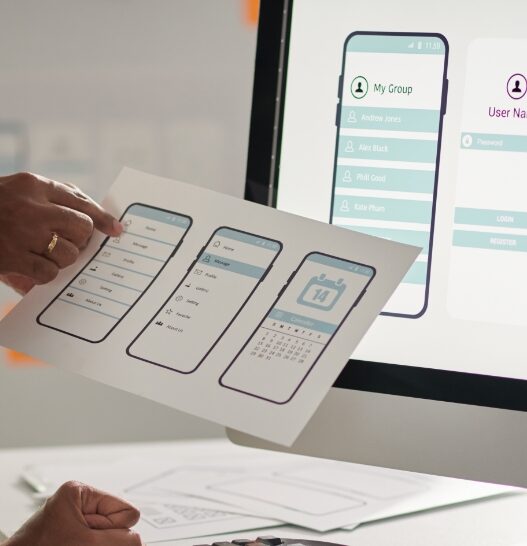You may have come across the concept of “context of use analysis” several times and now you want to know what exactly it is all about? How is the term defined? What methods are there? What is the exact procedure and what does the process look like? Why is a context of use analysis so important for your own product and how can you ensure that it is integrated into your own development process as profitably and efficiently as possible? And why exactly can you use Darth Vader and a frog as an example for the importance of context of use analysis?
If one or more of these questions interest you, then this article is for you. Here we clarify what exactly a context of use analysis is and offer you an interesting introduction to this exciting topic.
Definition of “context of use analysis”:
To define a context of use analysis, we must first look at how the context of use is defined. DIN EN ISO 9241-210:2011-01 provides information here. It is part of the “Ergonomics of Human-System Interaction” series of standards and provides the following definition of terms:
“Combination of users, goals, tasks, resources and environment.” It adds the definition: “The “environment” in a context of use includes the technical, physical, social, cultural, and organizational environment.”
Accordingly, a context of use analysis is the dissection of the use of a product, system, or service into the various components of users, tasks, equipment (hardware, software, and materials), and physical and social environment in which the product, system, or service is used.
The goals of context of use analysis:
A context of use analysis is done with the goal of answering the following questions:
- What is the user doing? This is about a deep understanding of the task the user is performing.
- What does he need to do it? Here you want to get an understanding of the user’s information and material needs.
- How does he do it? How often does he do it? How long does he do it for? By clarifying these questions, you build a deep understanding of the content flow of the user’s task.
- When does he do it? This is about understanding the timing of the process.
- Where does he do it? This is where you build an understanding of the spatial circumstances
- Why does he do it? This question is especially important to get an understanding about the user’s motivations and needs.
Why is a context of use analysis so important for your product?
We are certain that successful product design always starts with understanding the user. Here, context of use analysis is an important step to understand user needs in depth.
A product or service is always the solution to a problem. Context of use analysis helps you to understand the problem in depth, find out the user’s needs and develop the best possible solution approach that is accepted by the users.
Desirable in one context, inappropriate in another
In addition, a product can have several usage contexts and several user groups. Here it is important to know all contexts in order to adapt the product to all of them. For example, a device may work very well in one context, but be completely impractical in another. With the knowledge built up through context of use analysis, you can design your product to fit all situations and user groups.
Imagine a person who uses funny ringtones on their smartphone in a private context and has a lot of fun with them. For example, a message triggers a frog croak – and a call plays the epic Imperial March from Star Wars (you know, that’s the tune that comes on whenever Darth Vader comes on screen, – but I digress).
Imagine further that the same person is now sitting in a meeting in a work context. Here, it’s easy to imagine that the smartphone is not allowed to squawk under any circumstances. What has changed? The user is the same and the device is the same. Nevertheless, the smartphone triggers joy in one context and embarrassment in another. I have already anticipated the solution: The context is different. And that’s exactly why it’s so important to know the context of use in order to design the right user interface.
Context of use analysis also includes building an understanding of the standards and laws that apply to the context of use. If you are developing for the automotive industry, for example, there are very specific normative requirements for products here that do not have to apply in other areas. The better you know the context of use, the better you can integrate these normative requirements into product development.
The often neglected question “Which solution approaches have been tried so far and why didn’t they work?” holds enormous potential for your product development. This means that the context of use analysis also tells you what you can already rule out as possible solutions. In this way, you avoid designing a product that meets with user rejection.
Imagine further that the same person is now sitting in a meeting in a work context. Here, it’s easy to imagine that the smartphone is not allowed to squawk under any circumstances. What has changed? The user is the same and the device is the same. Nevertheless, the smartphone triggers joy in one context and embarrassment in another. I have already anticipated the solution: The context is different. And that’s exactly why it’s so important to know the context of use in order to design the right user interface.
Context of use analysis also includes building an understanding of the standards and laws that apply to the context of use. If you are developing for the automotive industry, for example, there are very specific normative requirements for products here that do not have to apply in other areas. The better you know the context of use, the better you can integrate these normative requirements into product development.
The often neglected question “Which solution approaches have been tried so far and why didn’t they work?” holds enormous potential for your product development. This means that the context of use analysis also tells you what you can already rule out as possible solutions. In this way, you avoid designing a product that meets with user rejection.
What methods are available?
There are a few conceivable methods for conducting a successful context of use analysis. The right method is crucial for the success of your analysis. In practice, a mix of methods is often used. In the following, we would like to present the most important ones from our point of view.
Field observation:
In field observation, users are observed and interviewed in their real (work) environment while performing the activity. Field observation is used to get to know the tasks, the environment and all external factors of the usage environment.
Interview:
Want to dig into all the interesting parts and gain deeper insights? Very good! Qualitative interviews provide you with incredibly important insights into the needs and desires of your own users. For your own product development, the answer to the question “Why did you do this step exactly the way you did?” worth its weight in gold.
So an interview helps you better understand the context and the user’s needs and wants, and if necessary, learn about them in the first place.
Contextual Inquiry:
And what happens when you marry the field observation and the interview? You’ve guessed it: A mixed method emerges, called Contextual Inquiry.
Here, the observer takes an active part in what is happening, as he interacts with the user and repeatedly hooks in with questions at interesting points. The result is the best of both worlds: Getting to know the external factors of the usage environment through the field observation and the qualitative insights about the users through the interview part.
Task Analysis:
Task analysis is often called sequence analysis. Here, the activity is broken down into individual steps. The resulting process, including all required inputs and generated outputs, is then documented. No new data is collected here. Rather, this is a type of data preparation that makes it possible to learn which features a user really needs to complete his or her task efficiently and effectively.
Focus Group:
A focus group is a moderated group survey about your product. Speed dating, so to speak, between users and your product. Inquired about:
- Subjective opinions about the product.
- Subjective wishes and needs regarding the product.
At this point we would like to recommend our method assistant. Here you can find out the best possible methods for your project with a few questions.
How do you ensure that you use a context of use analysis as profitably and efficiently as possible?
In order to also act as efficiently as possible, you should integrate the following points into your preparation:
- A stakeholder analysis – who is all directly or indirectly affected by your product?
- A review of existing inputs – what do you already know? Where are you already aware of knowledge gaps?
- The identification of unanswered questions.
- The choice of the right methods. A mix of methods is also conceivable and often most effective.
- Make sure you approach the analysis with the right mindset: You want to learn and improve your product.
You also act as effectively as possible when you organize the documented data and insights from your context of use analysis. The most critical and most frequently executed tasks should be the first focus of your product development.
To get the most out of the insights from your context of use analysis, you should also continue to develop your product in a user-centric way. That’s why, for us, context of use analysis is only the first step in the Data Driven UX design process. For the most efficient development, you should now iteratively improve your product and keep getting user feedback on it.
Interested in the entire Data Driven Design process? In our article “The pros and cons of Data Driven UX Design” you can get a first impression about the advantages and disadvantages. You can learn about the process in our article “From UX Testing to User Interface Design“.
Conclusion
Understanding one’s own user (groups) is essential for the success of one’s own product. The context of use analysis lays the foundation for this user understanding. Ideally, this is followed by iterative and data-centric user testing in order to tailor your own product as well as possible to user needs. It also helps you tailor the product to the context. Think again about Darth Vader or the frog at one of your meetings.
What challenges are you facing? Do you want to get to know your users and their tasks better? Let us know!
Feel free to comment below this post or contact us directly via our contact form. We look forward to hearing from you!
Do you have other topics related to context of use analysis that interest you? Feel free to let us know about that as well. We are very happy about any inspiration.



